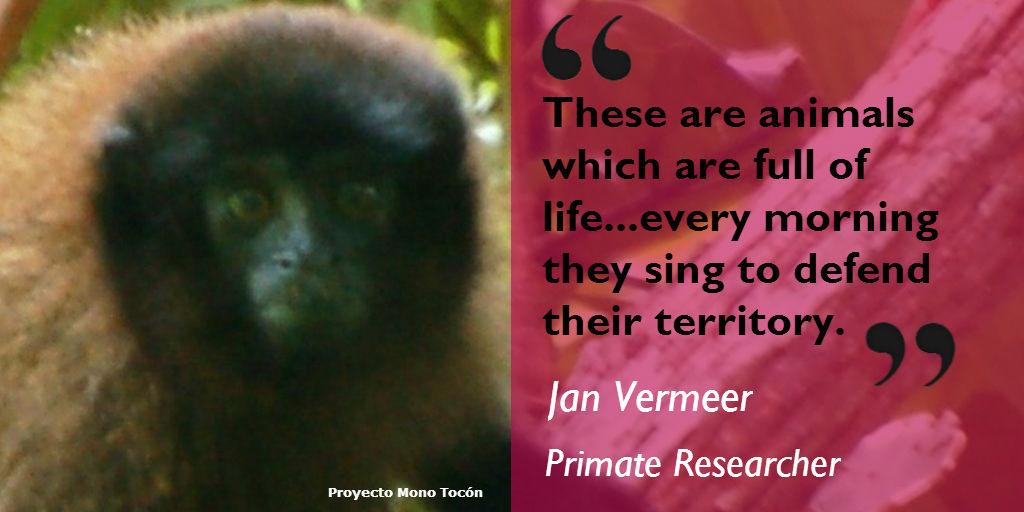
From New Scientist:
7 August 2015
New species of titi monkey discovered in remote Peruvian forest
A new species of monkey has been discovered on an expedition to the remote Urubamba river in Amazonian Peru. It has been named the Urubamba brown titi, Callicebus urubambensis.
Titis are the largest group of South American monkeys, and the discovery pushes the number of known species to 34, though the exact number is still a matter of some debate. Most are the size of a domestic cat, live in small family groups and defend their territories with howl-like roars.
“Its appearance is very distinct from other titis, the entire body and tail are much darker, and the face is all black,” says co-discoverer Jan Vermeer, coordinator of the Peru-based primate research programme, Proyecto Mono Tocón.
Each titi species has a specific colour pattern, and these patterns seem to be evolutionarily important.
Surprisingly, the new monkey seems to be common along a swathe of forest some 350 kilometres long.
“So often when a new monkey is discovered it is already threatened with extinction” says Vermeer. “This is a remote area with very little hunting, so for once this is not the case.”
The region in which the research was conducted, the Madre do Dios section of the Peruvian Amazon, is an area of extraordinary biological richness, with many species restricted to the forests between two large rivers. The width of the rivers – and the voracious piranhas that live in them – provide natural barriers to dispersion.
The expedition also allowed scientists to study another titi monkey species for the first time since it was described 100 years ago, the Toppin’s titi monkey (Callicebus toppini).
Vermeer and colleagues hope the discoveries will shed light on titi monkey evolution and dispersal, as well as help raise awareness of this remote and little-studied region.
“Titi monkeys are small and discreet. We are only just beginning to understand the factors driving their diversity,” says Stephen Ferrari of the Sergipe Federal University in Brazil. “A few decades ago, only five titi species were known. I think many more will be discovered as we explore southern Amazonia’s biologically uncharted forests.”
Journal reference: Primate Conservation










Dear friends,
A beautiful, far-flung piece of the Amazonian rainforest is under threat — vast swathes of untouched land home to jaguars, cougars and a vast range of flora and fauna are at risk of being destroyed by illegal coca growers and loggers. But with a stroke of his pen, the Peruvian Prime Minister could turn it into a National Park and save it.
The bill to protect the forest is on his desk and PM Cateriano is considering signing it right now — but every hour he doesn’t, this treasure is being destroyed. If he takes a stand against this illegal destruction, his leadership could inspire others to protect the planet and his example will echo down generations. But it’s up to us to make sure he knows that.
Activists in Peru say if Cateriano knows the whole world is supporting him, it will tip him to take action. Environmentalists and indigenous groups have been lobbying for twenty years to get this area protected. Let’s give it a final Avaaz push. Click to sign the petition, and Avaaz will deliver it directly to the Prime Minister’s office:
https://secure.avaaz.org/en/sierra_del_divisor_loc_imp/?bHFhfab&v=66518
Sierra del Divisor is a unique part of the Amazon. It’s home to many indigenous Peruvian communities, and one of the most biodiverse places on the planet. But time is running out. Illegal loggers, gold miners and coca growers are destroying it, and now there are rumours of road building and oil and gas operations that could threaten the area.
Some might say that making Sierra del Divisor a National Park will not be enough to stop illegal extraction. But National Park designation is like turning on a tap, and once you turn the handle, it gushes out manpower, financial resources, stricter regulations and inspections.
We’re almost there: since 2006, there has been a joint effort of conservationists, indigenous communities, government officials and the private sector all pushing to make Sierra del Divisor a protected area. Now it is finally ready to go — all it needs is one signature. Click to sign the petition — let’s show Cateriano the whole world cares, and wants him to be a hero:
https://secure.avaaz.org/en/sierra_del_divisor_loc_imp/?bHFhfab&v=66518
The Avaaz community has stood up time and again to protect our forests – last year tens of thousands of us donated to buy and protect an area where many of the world’s remaining orangutans live. Now let’s persuade Peru’s Prime Minister to be the leader the world is crying out for and save this majestic land.
With hope and determination,
Riccardo, Maria Paz, Oscar, Alice, Luis, Caro and the whole Avaaz team.
MORE INFORMATION
Peru stalling new national park for unique Amazon mountain range (The Guardian)
http://www.theguardian.com/environment/andes-to-the-amazon/2015/jul/29/peru-stalling-new-national-park-unique-amazon-mountain-range
Satellites Spot Deforestation in Almost-approved Peruvian National Park (Policy Innovations)
http://www.policyinnovations.org/ideas/commentary/data/00370
Sierra del Divisor Update: Final Stage of National Park Creation Reached (Rainforest Trust)
https://www.rainforesttrust.org/news/sierra-del-divisor-update-final-stage-creating-new-national-park-reached/
Will Sierra del Divisor soon become Peru’s newest national park? (Mongabay – Environmental News)
http://news.mongabay.com/2015/07/will-sierra-del-divisor-soon-become-perus-newest-national-park/
La coca y la tala amenazan sierra del divisor en riesgo (in Spanish – La Republica)
http://larepublica.pe/sociedad/17701-la-coca-y-la-tala-amenazan-sierra-del-divisor-en-riesgo
LikeLike
Pingback: Dutch government restricts trophy hunting | Dear Kitty. Some blog
Pingback: Dutch wildlife crime detected | Dear Kitty. Some blog
Pingback: How primates got fingernails, new research | Dear Kitty. Some blog
Pingback: Jamaica’s extinct monkeys, new research | Dear Kitty. Some blog